Have you ever wondered what it would be like to turn back the clock on aging? How would it be like to feel young again? To not worry about the symptoms of old age? Well, wonder no more, because gene therapy is here to shake things up in the world of longevity and vitality. Buckle up as we dive into the fascinating realm of gene therapy and uncover how it’s rewriting the rules of aging.
What’s Gene Therapy?
Picture this: a world where age-related diseases are a thing of the past, and we’re all living our best lives well into our golden years. Sounds like something out of a sci-fi movie, right? Well, thanks to gene therapy, this futuristic vision might just become a reality sooner than you think. Gene therapy is like the superhero of the medical world, swooping in to save the day by tinkering with our genetic code to combat diseases and slow down the aging process. But how does it do it?
Well, there is more than one way. But first, let’s understand genes and DNA.
Genes are tiny units of information found inside our cells that contain instructions for making proteins, which are essential for the structure and function of our bodies. These instructions are written in a molecule called DNA (deoxyribonucleic acid), which is like a long, twisted ladder made up of chemical building blocks called nucleotides. Each gene is a specific sequence of these nucleotides, and it carries the information needed to produce a particular protein. DNA is organized into structures called chromosomes, and humans typically have 46 chromosomes in each cell, arranged in 23 pairs. Genes play a crucial role in determining traits like eye colour, height, and susceptibility to certain diseases, and they are passed down from parents to children through reproduction.
Explain it to me like I am five?
Imagine your body is like a big instruction manual, and genes are like the tiny letters and words inside that manual. These genes are special because they tell your body how to do things, like what colour your hair and eyes will be or how tall you’ll grow. Now, DNA is like the paper that holds all those letters and words together in the instruction manual. It’s super important because it carries all the instructions that make you who you are, just like how a recipe card holds all the steps to make your favourite cookies. So, in simple words, genes are the instructions that tell your body what to do, and DNA is the special paper that holds all those instructions together! Cool, right?
Now, the actual topic. The different types of gene therapy.
Read More: Importance of Balanced Diet
Let’s Talk Telomeres: The Key to Youthful Cells
Alright, let’s get down to the nitty-gritty of how gene therapy works its magic. Ever heard of telomeres? They’re like the protective caps at the end of our chromosomes, keeping our DNA safe and sound. But here’s the kicker: these little guys shrink every time our cells divide, leading to cellular aging and all those pesky signs of getting older. Enter gene therapy, which aims to lengthen telomeres or rev up telomerase activity to keep our cells feeling young and sprightly.
Out with the Old, In with the New: Senolytic Therapy
Now, let’s talk about senescent cells – the grumpy old farts of the cellular world that refuse to retire. These cells might not be dividing anymore, but they’re still causing all sorts of trouble by spewing out inflammatory molecules, causing collagen breakdown, and wreaking havoc on our tissues. But fear not, because gene therapy is here to kick these troublemakers to the curb with senolytic therapy. By targeting and eliminating senescent cells, gene therapy helps clear the way for fresh, new cells to take their place, promoting tissue regeneration, collagen production, and keeping us feeling youthful.
Read More: Maintain a Balanced Diet
CRISPR-Cas9: The Game-Changer in Gene Editing
Now, let’s talk about CRISPR-Cas9 – the rockstar of gene editing technology. This revolutionary tool allows scientists to make precise changes to our genetic code, like fixing genetic mutations that are linked to age-related diseases. Think of it as a molecular pair of scissors that snips away the bad stuff and leaves us with nothing but good vibes and healthy genes. With CRISPR-Cas9, the possibilities are endless when it comes to personalized treatments tailored to our unique genetic makeup.
Read More: Foods That Suppress Appetite
Activating the Longevity Genes: Sirtuins, AMPK, and More
Last but not least, let’s shine a spotlight on the longevity genes – the unsung heroes of aging gracefully. These genes, like sirtuins, AMP-activated protein kinase (AMPK), and insulin-like growth factor 1 (IGF-1) signalling, hold the key to unlocking our body’s natural defences against aging. Gene therapy interventions aimed at activating these genes and pathways help boost cellular health, enhance resilience to age-related stressors, and keep us feeling vibrant and youthful.
Read More: Best Diet For Health
You want to know another benefit?
Gene therapy is also applicable to skincare! All the 4 aspects of gene therapy discussed above; they happen all over our body, including our skins. Meaning, gene therapy can revolutionise skincare, so we not only feel youthful, but also look youthful. No more wrinkly and saggy skin, only smooth and radiant beauty.
Navigating the Challenges Ahead
Of course, no superhero journey is without its challenges, and gene therapy is no exception.
- Safety Concerns: Ensuring the safety of gene therapy treatments is paramount. Off-target effects and unintended consequences could pose risks to individuals undergoing treatment, potentially leading to adverse reactions or long-term side effects.
- Ethical Dilemmas: Gene therapy raises complex ethical questions surrounding genetic manipulation and its implications for human enhancement. The ethical implications of altering our genetic makeup, especially for cosmetic purposes, must be carefully considered to ensure responsible use of this technology.
- Regulatory Hurdles: The regulatory landscape surrounding gene therapy is still evolving. Establishing clear guidelines and regulations for the development, testing, and approval of gene therapy treatments for any purpose is essential to ensure their safety and efficacy.
- Accessibility and Affordability: Gene therapy treatments may be costly and inaccessible to the general public, particularly in the early stages of development. Ensuring equitable access to gene therapy treatments is crucial to prevent disparities in healthcare outcomes based on socioeconomic status.
- Long-Term Effects: The long-term effects of gene therapy treatments on aging are still not fully understood. Longitudinal studies are needed to assess the safety and efficacy of gene therapy interventions over extended periods and to monitor any potential long-term side-effects of altering our DNA.
- Public Perception and Acceptance: Gene therapy may face resistance or scepticism from the public due to concerns about safety, ethical implications, and the perception of altering natural beauty. Educating the public about the potential benefits and risks of gene therapy in skincare is essential to foster acceptance and understanding.
Conclusion
And there you have it – a walk through the world of gene therapy process and types, where the rules of aging are being rewritten and a future where age truly becomes just a number is within reach. From lengthening telomeres to bidding farewell to senescent cells, gene therapy offers boundless potential for extending our health-span and ensuring we remain youthful and vibrant for years to come. So, here’s to the brave new world of gene therapy and the exciting adventures that await on our quest for longevity and vitality! Cheers to a future where aging gracefully is no longer just a dream, but a reality we can embrace with open arms!
FAQs
While gene therapy shows promise in addressing aging-related processes, such as telomere maintenance and senescent cell clearance, completely halting aging remains a complex and multifaceted challenge.
What are 5 examples of gene therapy?
Examples of gene therapy include CRISPR-Cas9 for gene editing, telomerase activation for telomere elongation, senolytic therapy for senescent cell removal, Sirtuin activation for longevity enhancement, and AMPK activation for cellular health improvement.
Gene therapy techniques encompass CRISPR-Cas9 for precise genome editing, viral vectors for gene delivery, RNA interference for gene silencing, and gene augmentation for adding therapeutic genes to treat various diseases.




